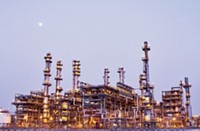Advertisement
Grab your lab coat. Let's get started
Welcome!
Welcome!
Create an account below to get 6 C&EN articles per month, receive newsletters and more - all free.
It seems this is your first time logging in online. Please enter the following information to continue.
As an ACS member you automatically get access to this site. All we need is few more details to create your reading experience.
Not you? Sign in with a different account.
Not you? Sign in with a different account.
ERROR 1
ERROR 1
ERROR 2
ERROR 2
ERROR 2
ERROR 2
ERROR 2
Password and Confirm password must match.
If you have an ACS member number, please enter it here so we can link this account to your membership. (optional)
ERROR 2
ACS values your privacy. By submitting your information, you are gaining access to C&EN and subscribing to our weekly newsletter. We use the information you provide to make your reading experience better, and we will never sell your data to third party members.
Business
Middle East: Capacity is growing, but so is the competition
by Alex Scott
January 13, 2014
| A version of this story appeared in
Volume 92, Issue 2

COVER STORY
Middle East Capacity is growing, but so is the competition
Supplies of cheap natural gas from U.S. shale deposits are growing while gas supplies in the Middle East are becoming constrained. That dynamic will be the shaping force this year for Persian Gulf chemical companies competing in international markets.
The Middle East petrochemical industry “is at a critical juncture and must be well prepared and positioned” to face these challenges, said Prince Abdulaziz bin Salman bin Abdul Aziz, deputy minister for Saudi Arabia’s Ministry of Petroleum & Minerals, in a speech in Dubai late last year. Middle Eastern firms are responding by investing in feedstock supply, boosting R&D, and expanding their presence in specialty chemicals that don’t depend so much on cheap raw materials.
The fertilizer sector, where Gulf producers have invested in some of the world’s biggest plants, could be adversely affected by increased exports from the U.S. in the coming years, according to London-based Business Monitor International, a market analysis firm. The Middle East’s fertilizer capacity is expected to increase by some 50% to 50 million tons per year by 2016, BMI says.
The Gulf’s polyethylene producers are also likely to face increased U.S. competition as ethylene crackers planned for the U.S. start cranking out polyethylene and other derivatives. At the same time, Middle East exports of polyethylene are expected to soar as production in the region ramps up, states BMI in a recent report on Saudi Arabia.
Half of all the new ethylene projects being developed globally are located in the Persian Gulf, BMI says, and through 2017 the Middle East could add almost 6 million tons per year of ethylene capacity.
Saudi Arabia is the region’s largest overall exporter of petrochemicals. It is set to account for 16% of global petrochemical production in the next five years, up from around 10% in 2013, as capacity expands and Asian demand continues to grow, BMI states. Overall, however, “the days of new massive olefins projects may be over,” BMI predicts.




Join the conversation
Contact the reporter
Submit a Letter to the Editor for publication
Engage with us on Twitter